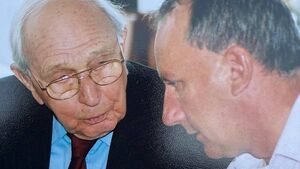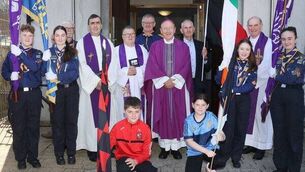In memory of ATGWU 'legend' Pat Fitzgerald

Pat Fitzgerald pictured in 2004 in discussion with Jack Jones, former General Secretary of the inion, when Jack visited the factory. Photo: John Power
On behalf of the entire membership and leadership of Unite the Union, formerly the ATGWU, and all of the local branches, can I extend my condolences to all of Pat Fitzgerald's family on the tragic loss of Pat.
The Irish Secretary of our union, Susan Fitzgerald, has asked me to convey her sincere condolences to Pat's family and she will be in touch with the family at a time appropriate to do so.
I was honoured to have been invited by Pat’s family to speak at his Funeral Mass.
First of all, can I give a mention to Maura, Pat's mother, who was great friends with my own mother Kitty.
Also, I would like to mention Kathleen, Pat's wife, who always extended her famous hospitality to me whenever I called to their house.
Pat was one of 10 children, born to Maura and Jack Fitzgerald, six girls and four boys. He attended Mount Sion where he excelled in sport and studies.
In February 1970 like so many young men and women he joined Waterford Crystal as an apprentice blower to commence a five-year training programme, leading to becoming a qualified Blower Craftsman, and, in turn, in 1970 Pat became a member of The Amalgamated Transport and General Workers Union.
Having worked closely with Pat for decades I have some great memories of Pat and for sure a lot happened in Pat's time across the Waterford Crystal factory, across our union, the ATGWU, now Unite the Union, and the local trade union movement through the Waterford Council of Trade Unions.
As the Chairman of the Union Branch and Joint Negotiating Committee, holding one of the two senior convenor elected positions, Pat was centrally involved in all of those issues and events throughout those years.
Pat came through the 'Glass Blowing' section having been a union representative for the Blowers. He then began working with myself, I having come through the 'Cutting' section, and we worked together in the full-time positions, being continuously elected by the membership.
The lay positions of shop stewards are the foundation on which the Union is built. Pat was committed as a lay member, never interested in becoming an appointed union official.
Pat gave his working life to Waterford Crystal and also to the Union. Without fear of contradiction, it can be said that while Fitzy worked at the factory, he was a living legend. The history of Waterford Glass is Pat Fitzgerald's history, Pat's history is the history of Waterford Glass.
Getting to know Pat you knew a man who had an astute brain, was good at reading a situation and coming to a conclusion on the best way forward.
When we did get agreement on a position, the challenge for Pat as the chairman was then to bring all of the union representatives in Waterford and Dungarvan Crystal to an agreed position, which could then be brought as a recommendation to all of the members.
This would be at regular monthly open branch meetings in the Union office in Keyser Street and then during those years of hugely important decisions affecting our future employment, these issues would be dealt with through mass meetings in local hotels, the Ardree, the Tower Hotel or the Woodlands.
There was no hiding place when you were the Chairman and Pat had the industrial skills and the people skills to steer that ship through what he often described as “through shark infested waters”.
Pat, as those who knew him well, was someone who, on certain issues, would be difficult to shift off a particular view, such would be his determination, but he was also committed to resolving matters through a consensus.
It was never going to be easy to deliver that consensus across 40 shop stewards and then through an entire workforce.
Branch Chairmen in other situations would sometimes take a view of only being on board for their own internal workplace issues.
Fitzy was on board for issues and campaigns outside of Waterford Crystal – like support for the Kitui appeal where there was a basic need for clean water treatment in that part of Africa, the Fight for Sight campaign, the Radiotherapy campaign, the Cardiac Care campaign.
Those campaigns would be supported and co-ordinated by others in the workplace but it was Pat's job to bring them through meetings with the members and, where appropriate, to get agreement for a wage deduction, the Liverpool Dock Strike being a good example.
I can remember Pat going around putting union notices on union notice boards calling a meeting to support a weekly wage deduction for the striking dockers in Liverpool.
The wage deduction started the first week of the strike and continued right through to the end.
This support from the Crystal workers is marked with a special plaque mounted in the dockers club on Hope Street in Liverpool, thanking the Branch – similar support for the 1984 Miners' Strike. All of those issues are highlights of Fitzy's time as our Chairman.
Chairing the JNC throughout our own three-month strike in 1990 was another massive challenge – a defensive strike in itself was never going to bring gains, the task was to defend and maintain as much of our wages and conditions as possible.
Eight weeks of meetings held daily in the Ardree was a strain on every shop steward and every member at the open meetings but it fell to Pat to hold the organisation together for the future.
And, of course, after the disaster of the factory closure the fight for Pension Justice was thankfully in the end “Justice Delivered”.
Reporting back to our members on the result of our successful efforts in the Woodlands Hotel I am reminded that this probably represents the last meeting that Fitzy had to Chair.
In conclusion – today I am saying farewell to a lifelong friend and comrade.
Rest in Peace Fitzy.






